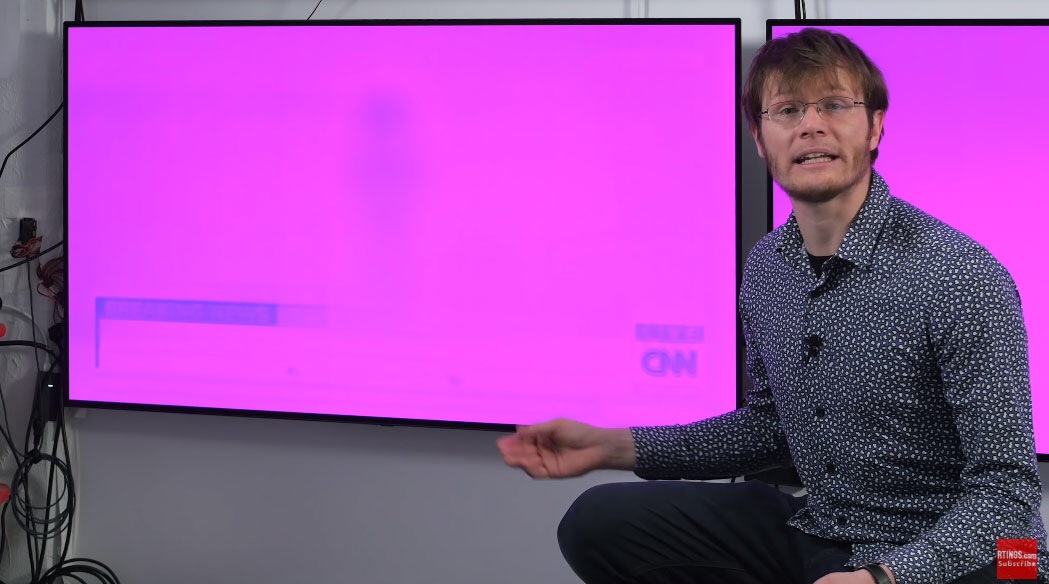買電視機換電視機集中討論區(11)有問題睇左#1先
雙面人22號
1001 回覆
2 Like
0 Dislike
43吋係咪唔推介買LG?
係咪各方面都贏X9500G 我見價錢差不多
著重黑位,會成日熄燈睇戲,唔長開固定畫面既就oled
新人留名 32寸個啲係咪唔好買 記得有巴打話過啲料好差
點樣可以減到12580?
上個po,巴打係aeon 買都係14580*0.88 = 12830
上個po,巴打係aeon 買都係14580*0.88 = 12830
如果長時間睇新聞台,長時間有條色bar著住,或者電視台既logo都會引致燒印
例如會出現咁既情況

Samsung tv
個pc連接係咪最多一部pc?
我一部hdmi 再加多部藍芽
部藍芽就連唔到
個pc連接係咪最多一部pc?
我一部hdmi 再加多部藍芽
部藍芽就連唔到
巴打,testing from rtings 話5000 hours 既long period static content 先會導致burn in. 即係講緊每人玩2 個鐘call of duty, 玩足7 年,就會產生燒印。所以一般每日睇兩,三個鐘電視,而唔係長開的話。其實沒問題。
Original statement from 11/05/2018: After more than 5000 hours, there has been no appreciable change to the brightness or color gamut of these TVs. Long periods of static content have resulted in some permanent burn-in (see the CNN TVs), however the other TVs with more varied content don't yet have noticeable uniformity issues on normal content. As a result, we don't expect most people who watch varied content without static areas to experience burn-in issues with an OLED TV. Those who display the same static content over long periods of time should consider the risk of burn-in though (such as those who watch lots of news, use the TV as a PC monitor, or play the same game with a bright static HUD). Those who are concerned about the risk of burn-in should go with an LCD TV for the peace of mind.
Note that we expect burn-in to depend on a few factors:
The total duration of static content. LG has told us that they expect it to be cumulative, so static content which is present for 30 minutes twice a day is equivalent to one hour of static content once per day.
The brightness of the static content. Our maximum brightness CNN TV has more severe burn-in than our 200 nits brightness CNN TV.
The colors of the static areas. We found that in our 20/7 Burn-in Test the red sub-pixel is the fastest to degrade, followed by blue and then green.
To see how the results at this 5000 hour point compares to your usage, divide 5000 by the number of hours you watch each type of content per day to find the number of days. For example, someone who plays call of duty or another video game without bright static areas for 2 hours per day may expect similar results after about 2500 days of usage. This corresponds to about 7 years.
We will continue to run this test and collect data, and our stance may change as we obtain more information.
https://www.rtings.com/tv/learn/real-life-oled-burn-in-test
Original statement from 11/05/2018: After more than 5000 hours, there has been no appreciable change to the brightness or color gamut of these TVs. Long periods of static content have resulted in some permanent burn-in (see the CNN TVs), however the other TVs with more varied content don't yet have noticeable uniformity issues on normal content. As a result, we don't expect most people who watch varied content without static areas to experience burn-in issues with an OLED TV. Those who display the same static content over long periods of time should consider the risk of burn-in though (such as those who watch lots of news, use the TV as a PC monitor, or play the same game with a bright static HUD). Those who are concerned about the risk of burn-in should go with an LCD TV for the peace of mind.
Note that we expect burn-in to depend on a few factors:
The total duration of static content. LG has told us that they expect it to be cumulative, so static content which is present for 30 minutes twice a day is equivalent to one hour of static content once per day.
The brightness of the static content. Our maximum brightness CNN TV has more severe burn-in than our 200 nits brightness CNN TV.
The colors of the static areas. We found that in our 20/7 Burn-in Test the red sub-pixel is the fastest to degrade, followed by blue and then green.
To see how the results at this 5000 hour point compares to your usage, divide 5000 by the number of hours you watch each type of content per day to find the number of days. For example, someone who plays call of duty or another video game without bright static areas for 2 hours per day may expect similar results after about 2500 days of usage. This corresponds to about 7 years.
We will continue to run this test and collect data, and our stance may change as we obtain more information.
https://www.rtings.com/tv/learn/real-life-oled-burn-in-test
我咪講左唔長開咪無事

今日本想買P記th55gx740H,然後諗諗下平時都係拎部電視嚟睇直播打機,玩下PS4SWITCH。都係買LG部UM7400PCA算



鐘意就去馬啦

32吋有咩揀

唔送 加399 lg 原廠架連安裝
終於入左x9500g 整體上好滿意
但係想問下大家用唔用Netflix mode? 我用左覺得好似暗左啲 但係又睇唔出有咩特別
大家又點睇?

但係想問下大家用唔用Netflix mode? 我用左覺得好似暗左啲 但係又睇唔出有咩特別
大家又點睇?